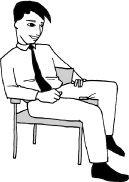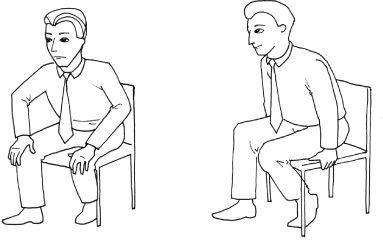Read The Definitive Book of Body Language Online
Authors: Barbara Pease,Allan Pease
The Definitive Book of Body Language (39 page)

Contradictory signals: his right arm shows pointed aggression, while his left hand attempts to protect his front
This is almost entirely a male gesture and is also seen among apes who are trying to establish authority over other apes. Rather than risk injury fighting, they spread their legs and the one with the biggest display is seen as the most dominant. And so it is with male humans; even though it's usually done unconsciously, it sends a powerful message. If one man does the Legs-Spread the others usually mirror to maintain status, but it has very negative effects when a man uses it in front of women, especially in a business context, because she can't mirror it.
A woman will feel intimidated by a man
who uses the Legs-Spread in business situations.
Our videotaped meetings reveal that many women respond by crossing their legs and arms, which immediately puts them on the defensive. The advice for men here is clear—keep your legs together in business meetings. If you're a woman who is constantly confronted by a crotch-displaying male, don't react when he does it. It can work against you only if you respond
defensively. Instead, try talking to his crotch—responses such as “You've got a good point there, Bob” and “I can see where you're coming from” can teach a valuable lesson as well as causing riotous laughter when used at the right time.
This is mainly done by men because it also uses the Legs-Spread. It not only signifies the man's ownership of the chair, it also signals that he has an informal, aggressive attitude.

Informality, indifference, and lack of concern
It is common to see two male friends laughing and joking with each other while sitting this way, but let's consider its impact in different circumstances. Let's say an employee has a personal problem and goes to ask his boss for advice. As the employee explains, he leans forward in the chair, his hands on his knees, his head down, with a dejected expression and voice lowered. The boss listens, sitting motionless, then leans back in his chair and puts one leg over the arm. The boss's attitude has now changed to lack of concern or indifference. In other words, he has little concern for the employee or his problem and he may even feel that his time is being wasted with the “same old story.” So what was the boss indifferent about? He may have considered the employee's problem, decided that it's not much of a problem anyway, and become disinterested. He may even tell his employee not to worry and that the problem will simply go away.
As long as the boss's leg stays over the arm of the chair, his indifferent attitude will persist. When the employee leaves the office, the boss breathes a sigh of relief and says to himself, “Thank heavens he's gone!” and takes his leg off the arm of the chair.
The Leg-Over-the-Arm-of-Chair can be annoying when it occurs during negotiation, and it is vital to make that person change position because the longer he stays in it, the longer he will have an indifferent or aggressive attitude. An easy way to do this is to ask him to lean across and look at something, or, if you have a wicked sense of humor, tell him there's a split in his trousers.
Centuries ago, men used shields to protect themselves from the spears and clubs of the enemy, and today, civilized man uses whatever he has at his disposal to symbolize this same protective behavior when he is under physical or verbal attack. This includes standing behind a gate, doorway, fence, desk, or the open door of his motor vehicle and straddling a chair.

The Straddler wants to dominate or control while, at the same time, protecting his front
The back of the chair acts as a shield to protect the body and can transform a person into an aggressive, dominant personality. Men also have their legs spread in a wide Crotch Display, adding male assertion to the position. Most Straddlers are dominant types who will try to take control of others when they become bored with the conversation, and the back of the
chair serves as good protection from any “attack” by other members of the group. The Straddler is often discreet and can slip into the straddle position almost unnoticed.
The easiest way to disarm the Straddler is to stand up or sit behind him, making him feel vulnerable to attack and forcing him to change his position. This can work well in a group situation because the Straddler will have his back exposed and this compels him to change to another position.
So what would you do with a Straddler on a swivel chair? It is pointless to try to reason with a crotch-displaying man on a merry-go-round, so the best defense is nonverbal. Conduct your conversation standing up and looking down on the Straddler, and move into his Personal Space. This is unnerving for him and he can even fall backward off his chair in an attempt to move away.
Next time you have a Straddler coming to visit you, be sure to seat him on a fixed chair that has arms to stop him from taking his favorite position. When he can't straddle, his usual next move is to use the Catapult.
This is a seated version of the Hands-on-Hips pose except the hands are behind the head with the elbows menacingly pointed out. Again, it's almost entirely a male gesture used to intimidate others or it implies a relaxed attitude to lull you into a false sense of security just before he ambushes you.

The Catapult: cool, confident, knows it all, and thinks he has more bananas than anyone
This gesture is typical of professionals such as accountants, lawyers, sales managers, or people who are feeling superior, dominant, or confident about something. If we could read this person's mind, he would be saying things such as, “I have all the answers,” or “Everything's under control,” or even “Maybe one day you'll be as smart as me.” Management personnel regularly use it and newly appointed male managers suddenly begin to use it, despite the fact that they seldom used it prior to their promotion. It is also used by “Know-It-All” individuals and it intimidates most people. It's the trademark gesture of men who like you to realize just how knowledgeable they are. It can also be used as a territorial sign to show that the person has staked a claim to that particular area.
It is usually clustered with a Figure Four leg position or Crotch Display, which shows that he not only feels superior, he's also likely to argue or try to dominate. There are several ways you can deal with this gesture, depending on the circumstances. You can lean forward with palms up and say, “I can see that you know about this. Would you care to comment?” then sit back and wait for an answer.
Women quickly develop a dislike for men who
use the Catapult in business meetings.
You could place something just out of his reach and ask, “Have you seen this?” forcing him to lean forward. If you are a man, copying the gesture can be a simple way to handle the Catapulter because mirroring creates equality. This doesn't work for a woman, however, because it puts her breasts on display, leaving her at a disadvantage. Even flat-chested women who attempt the Catapult are described as “aggressive” by both men and women.
The Catapult doesn't work for
women, even flat-chested ones.
If you are a woman and a man does this, continue the conversation standing up. This forces the Catapulter to change position so he can continue the conversation. When he stops the Catapult, sit down again. If he catapults again, stand up. This is a nonaggressive way of training others not to try to intimidate you. On the other hand, if the person using the Catapult is your superior and is reprimanding you, you will intimidate him by copying this gesture. For example, two equals will use the Catapult in each other's presence to show equality and agreement, but if a mischievous schoolboy did it, it would infuriate the school principal.
In one insurance company, we found that twenty-seven out of thirty male sales managers used the Catapult regularly around their salespeople or subordinates but rarely in the presence of their superiors. When they were with their superiors, however, the same managers were more likely to use submissive and subordinate gesture clusters.
One of the most valuable gestures a negotiator can learn to recognize is seated readiness. When you are presenting a proposal, for example, if the other person were to take this gesture at the end of the presentation, and the interview had gone well up to that point, you could ask for agreement and would be likely to get it.

The classic position showing readiness for action
Our video replays of salespeople interviewing potential buyers revealed that, whenever the Seated Readiness gesture followed a Chin-Stroke (decision-making), the client said yes to the proposal more than half the time. In contrast, if during the close of the sale the client took the Arms-Crossed position immediately after the Chin-Stroke, the sale was usually not made. The Seated Readiness gesture can also be taken by the angry person who is ready for something else—to throw you out. The preceding gesture clusters indicate the person's real intentions.
Readiness gestures that signal a desire to conclude a meeting include leaning forward with both hands on both knees, or leaning forward with both hands gripping the chair as if they were at the start of a race. If either of these occur during a conversation, it would be wise for you to take the lead and resell, change direction, or terminate the conversation.

